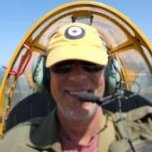-
Posts
115 -
Joined
-
Last visited
-
Days Won
1
tbell last won the day on January 10 2013
tbell had the most liked content!
Profile Information
-
Gender
Male
-
Location
Guelph, Ontario, Canada
tbell's Achievements

New Member (2/9)
261
Reputation
-
I did my Wingnut Wings Albatros prop the same way, but with hand cut masks. Just be sure to study the laminations pattern on the real thing; it's quite distinctive and simple strips don't replicate it accurately.
-
If the profile of the individual blades is similar, I don't see why not.
-
Thanks, Bob. The prop laminations were masked and painted. I drew the masks on the computer, ellipses for the front and strips for the rear, and cut them on my Silhouette Portrait computer controlled cutter. The light colour is Vallejo Air Radome Tan and the dark colour is Vallejo Panzer Aces Light Rust. I applied a very light coat of thinned raw sienna oil paint which I streaked with a piece of torn sponge for a subtle (almost too subtle) wood grain. Cheers, Tony
-
Doing well, thanks. Getting the results from the latest CT in a couple of weeks. I’m pretty confident it’s all clear. See you at Heritagecon?
-
Thanks for the feedback, Roger. I hadn't seen the Arma research before now. I did consider doing a streaky finish on the wing, but the only clear photos I could find depicting the streaking were the ones of the Polish machines in post-war service. All of the photos of wartime German machines were inconclusive at best, and considering how evident the streaking is in photos of the Dr.I, I figured that if the E.V did have streaking it would have been more obvious. That one photo on Arma's page of the wing being stress tested does show the streaking pretty clearly though, doesn't it? As for the crash pad, those appear only to have featured on the Polish machines. All the photos of German E.V's that I came across that clearly showed the cut-out definitely did not have it. Cheers, Tony
-
tbell started following IBG 1/35 Bedford QLR and Eduard Fokker E.V
-
Eduard's now OOP 1/48 Fokker E.V, built mostly OOB save for the gorgeous Master turned brass MG cooling jackets and barrels. Lovely little kit, although getting the wing straight & level was a PITA. Constructive criticism welcome! Cheers, Tony Bell
- 34 replies
-
- 37
-

-
Thanks. For the SCC15 I used Mike Starmer’s recipe and mixed 5 parts Tamiya XF81 RAF Dark Green with 1 part XF85 Olive Green and 1 parts XF71 Cockpit Green. I added some XF49 Khaki to lighten it up a bit, plus some X22 clear to make it more durable and to give it a bit of a sheen. The SCC14 is simply XF69 NATO Black.
-

1/48 Eduard Supermarine Spitfire Mk.IXc RAF 310 Sqn
tbell replied to madcat911's topic in Ready for Inspection - Aircraft
Nice looking Spit! I have a couple Eduard kits in the stash and I really must get going on one these days. One thing you may wish to bear in mind if you decide to do another one is that the propeller blades were actually made of wood with a brass leading edge, so aluminum chipping would not be strictly accurate. -
To be clear, I was being facetious about the wood drive shafts! I was playing along with Badder's comment re. the toothpick I used to hold the engine... It's a nice kit, albeit somewhat like a short run. IBG's recent Scammell is considerably more refined (minor accuracy issues notwithstanding)
-
Nah, that was sarcasm (which we all know always comes across so well on the interwebs...)
-
I replaced the kit styrene windows with acetate from an office supplies store, cut on my Silhouette Portrait electronic cutter to depict them rolled down.
-
Bedford made their lorry drive shafts from wood in an effort to conserve strategic materials for combat vehicles. True story!
-
LOL, thanks! It's the Ultracast 1/32 "WWII German Fighter Pilot" cat. no. 54004. Mike Good's sculpting is outstanding, which makes painting much easier.
-
I generally wing it with the exact mix. IIRC, I used Burnt Sienna with a touch of Burnt Umber. Other shades I use are Yellow Ochre, Raw Umber and Naples Yellow (for blonde wood). I also like to use oils for leather. The technique is exactly the same except instead of streaking, I stipple with a soft, dry brush.
-
Thanks all for the kind words! The wood finish is simply artists oil paint on top of Tamiya XF15 Flesh, a technique that I honed on WWI aircraft models. I put a dab of oil paint on a piece of corrugated cardboard for about 30 min to draw out the excess linseed oil and then mix it with a bit of drying medium (stand oil in this case). I brush a thin coat of the oil paint on the piece and then create the grain by dragging it with a clean rake brush. The softer the brush, the finer the grain, so you can use this technique in any scale. It's workable for several hours (takes a couple of days to dry), so you can mess about with it until you have it just so.





